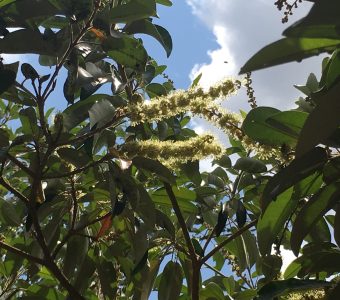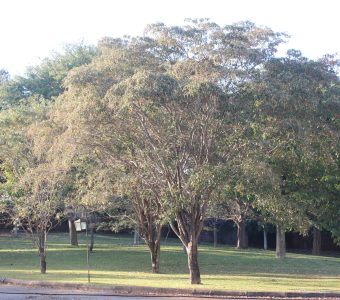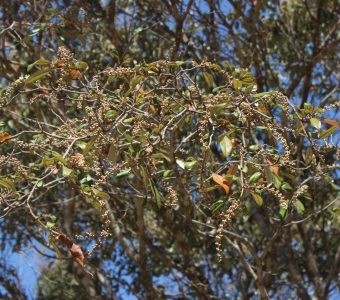


Botanical Name: Croton gratissimus Burch.
Synonym: C. zambesicus Mull.Arg.
Common Name: Lavender Feverberry or Lavender Croton
Plant Family: Euphorbiaceae
Origin: Africa
References: Coates Palgrave p.493, Joffe p.52, Johnson 1, p.103. S.A. No. 328, Zimb. No. 478
Description: A graceful, dropping, small to medium-sized, elegant, multi stemmed tree that gives good dappled shade under a spreading canopy. It is evergreen but continuously drops leaves. Under surface of leaves have distinctive and beautiful silver or golden satiny sheen produced by dense scales. Tiny creamy yellow flowers are carried in spikes throughout the wet months and in a garden for much of the dry season as well. The fruit is a small, orange, dehiscent, three-lobed capsule.
Features of Particular Interest: The eye-catching foliage of the Croton is that changes color as the wind blows is its most attractive feature. It has bi-colored leaves (orange/green) with a snow white, silvery under surface sometimes with embellishing dots. The leaves turn a beautiful orange before they drop so that the green and silver colors are always flecked with orange.
Height and Spread: 3 – 5 m height, 4 – 6m spread.
Periods of Interest:
Leaf: All year round.
Flowering: October to July.
Fruiting: February to July.
Cultivation
Soil and Moisture: Croton requires deep freely draining soil and will grow fairly quickly. It should be planted in the full sun for full impact. It is not hardy and requires protection from frost.
Maintenance and Pruning: It will grow faster if watered once a week for first two dry seasons. Pruning is not usually required.
Propagation: Readily from fresh seeds in a sandy growing medium.
Problems and Drawbacks: It could be considered a bit messy as it drops leaves all year. Although it has prolific flowering branches, seed is difficult to collect.
Use and Associated Planting: C. gratissimus makes a specimen tree in the lawn especially in a small garden, or as part of a mixed screen. Its roots are not invasive. It may also be used in an avenue or car park as its roots is not invasive. It gives good shade for spectators by a tennis court.
